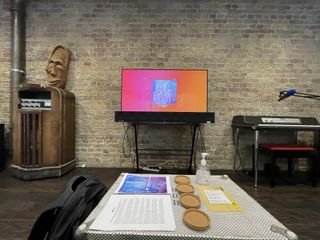It’s very rare for me to turn down the offer to go to a recording studio, so when Dolby asked if I’d like to see where music is mixed into Atmos, I couldn’t say yes quickly enough. So I headed over to Eastcote Studios to sit down and hear what they’ve been doing with Dolby to revolutionise the sound of music. Eastcote is one of a select group of Atmos capable mixing locations and Dyre Gormsen is a Grammy nominated sound engineer who sat me down to hear what spatial audio should sound like.
The track I listened to was “yellow face” by Henjila and what made this experience unique was that she popped by later in person to sing it live. It’s quite rare that you get the chance to hear something in surround sound, then later hear it again in the same room as the artist. But it was a very interesting comparison to make. Gormsen told me that the mix is derived from the stereo master, but will end up sounding very different. It’s a totally new work, and for that reason artists need to sign off on it.
In the Atmos version the vocal appears on the “centre” channel. Atmos somewhat dispenses with the idea of channels, but this is where dialogue comes from in movies. This was, for me, the most significant part of the experience. Separating the vocals out, and putting them in front of you is remarkable. You hear Henjila singing about her experiences as if she’s standing in front of you. Instrumentation then fills the room, thanks to Atmos’ spatial positioning.
- IRIS' Flow wireless headphones made my girlfriend cry
- GTA 6's rumored evolving Fortnite-style seasonal map sounds incredible

With Apple Music there’s a growing selection of Atmos mixes, and it’s making me very keen to hear some of it on a proper surround sound system. While I certainly like the spatial audio experience through headphones, it certainly doesn’t blow me away like it did through a proper surround sound system.
Of course you might be thinking that a studio setup with amazing amps and speakers, costing tens of thousands to build, isn’t a fair test. I agree, so when the guys in Eastcote Studios then let me hear the playback on a Sennheiser Ambeo Soundbar I was just as blown away. In fact, I’d say that the reproduction was staggering. The Ambeo isn’t cheap either, it’s more than £2,000 (AU$3,999), but I suspect that you could find a price point that suits you and get a really good experience.
When I got home I fired up Henjila’s track on my own stereo. I have a pair of delightful Dali bookshelf speakers and a Cambridge Audio Evo 75 I’m testing. The sound was amazing, but lacking that centre channel and the freedom on the instruments that the Atmos mix brought left me feeling a bit bereft.

So what are my conclusions here? Firstly, as I’ve always said, Atmos when done right is a remarkable technology. It’s hard to get it right at home, and I’m thinking about this a lot at the moment because I really want the full surround experience for my lounge. Secondly, headphones are good but I think speakers still have the edge for spatial audio. I’m excited for what comes in the future and I want to hear more Apple Music via a surround sound system.
Finally, I am totally convinced that music should be delivered in Dolby Atmos. Of course, the wishes of the artist are important and this won’t be for all. But when there is a willingness, the intimacy of the delivery and the scope to really pick out instruments individually has enormous potential.
Dolby keeps doing this to me. I go along and watch a film, or listen to some music, and the next moment I’m on the internet thinking about blowing through next month’s mortgage payment on new equipment to experience it. Curse you Dolby, curse you and your mind-blowing audio.


